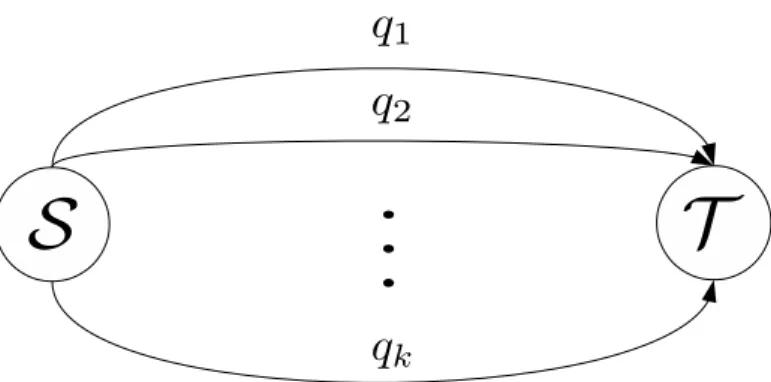Previous work has shown that when hop-by-hop feedback is not available, network coding is necessary to achieve the maximum throughput in the network [1]. In the second problem, we deal with the detection of malicious attacks in a distributed storage system using coding.
Background and Related Work
Network Coding
Distributed storage systems introduce redundancy to increase reliability and use encryption as storage requirements are reduced as simple replication [2]. However, when encryption is used, the distributed storage system is particularly vulnerable to malicious attacks.
Information Theoretic Security
Thesis Outline and Contributions
A major technical challenge in analyzing the delay function for the routing strategy involves computing the expectation of the maximum of two independent negative binomial random variables. We show a finite bound on the delay function that applies to both coding and the routing scheme when there is a single weakest link.
Model
Since ETnc increases linearly in n and the deviations ϵn are sublinear, Tnc is strongly centered around its expectation for large n with probability approaching one. Our results hold without any restriction on the number of packets n or the number of edges in the network, and there is no requirement for the network to reach steady state.
Line Networks
For each removal realization, the evolution of the number of innovative packets on each node is the same in encryption and routing. A direct consequence of Proposal 1 is that the expected time Eτn for the remaining innovative packets on nodes N1, .

Coding Strategy
Therefore, without loss of generality, we will assume that the first link in any path is one of the worst links in the path. In case the first link of each path is the unique worst link of the path, as shown in [48], each line network will reach a stable state and hence E(R)∈O(1).
Routing Strategy
You can see this by swapping the positions of the links so that the worst links of each path are at the beginning. As shown in equation (2.9), to minimize the expected time to completion, the routing strategy sends 2n(1−q−q1).

General Network Topologies
For each node v∈ V in the network G, let Kv denote the set of flows passing through the node v, where KS and KT are equal to the set of all flows in the network G. Collapse all nodes of the set VS into one node ˆS, which denotes the origin in the network ˆG , and.
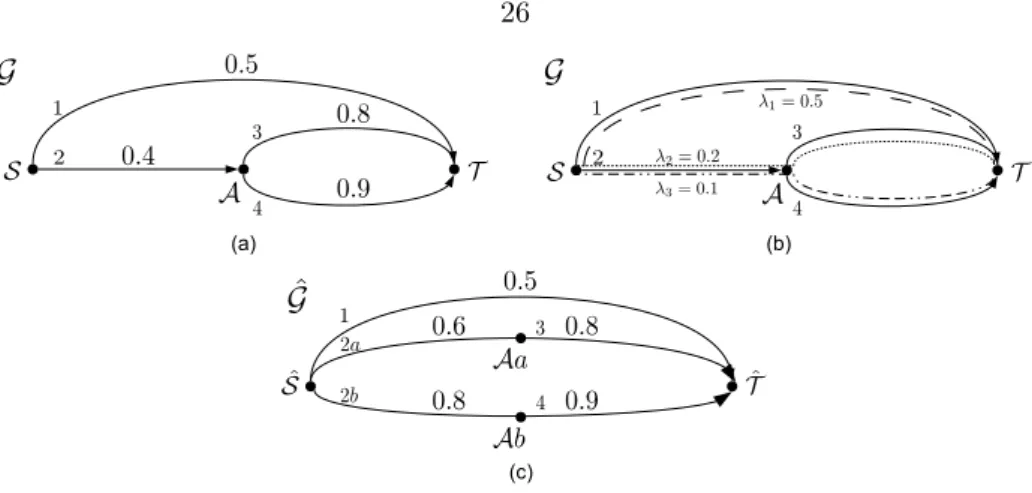
Proof of Concentration
A part of the literature studies the secure capacity of the interception channel introduced by Wyner in [17]. Using these bounding and equivalent results, secure bounds on the network coding capacity can be applied to bound the secure capacity of a network of eavesdropping channels. noiseless eavesdropping is derived by generalizing the techniques developed by Koette, Efros, and Medard in [31, 32], which show similar capacity bounds in the absence of secrecy constraints.
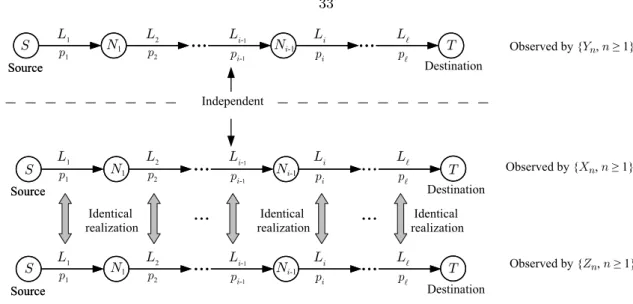
Network Model
In the case where the eavesdropper has access to only one connection whose identity is unknown to the code designer, the upper and lower limits of the secure network's encryption capacity are identical. This result gives an equivalence in the sense that the capacity regions of noise-free and noisy networks are identical for all possible topologies and all possible types of links that can be placed in the entire network. The maximization in Definition 6 is subject to any channel input constraints (eg, the input power constraint of a Gaussian channel) associated with the communication network of interest.
It is also simultaneously maximizable since independently maximizing the entropies of components of X(¯e),c and X(¯e),p of the channel input maximizes the mutual information for both the intended receiver and the eavesdropping output. Many of the proofs in the sections that follow rely on the notion of a “stacked network” introduced in [31, 32].
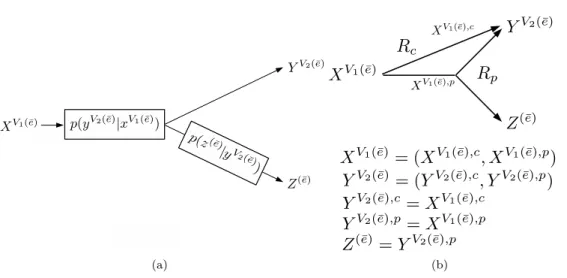
Intuition and Summary of Results
I(X(¯e);Z(¯e)), as shown in Figure 3.1(b), yields a new network Ne¯(Rc, Rp) whose capacity range is a superset of the safe capacity range of N. The noise-free network Nˆ is an upper bound model for the network in Figure 3.2(b) (and therefore also an upper bound model for the network in Figure 3.2(a), which gives R(N, A) = R( ˘N, A ) ⊆ R( ˆN , A)), and is obtained by two applications of Theorem 9. Direct emulation of this solution over the corresponding noisy links in the ˘N network of Figure 3.2(a) fails to maintain security.
The first lower bound results from removing the public part of the upper bound model. Hyperarc hi silently delivers the same rate-Cˇ(i) description from node vi to all the nodes in {i}.
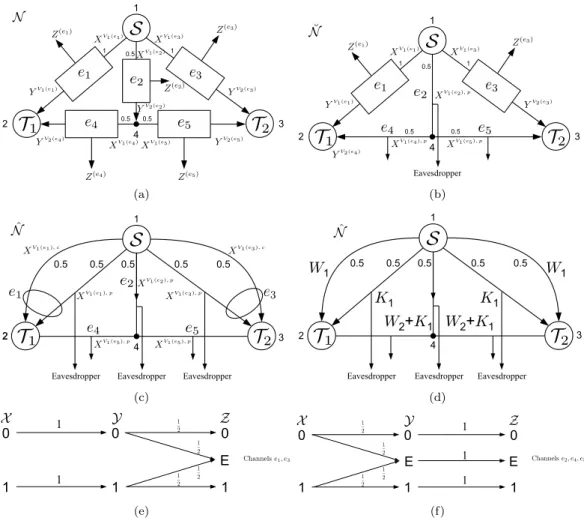
Proofs
Proof of Theorem 9
Unlike the rest of the results, where changing a single eavesdropping channel Ce¯ to its noise-free counterpart C¯e(Rc, Rp) results in an equivalent or bounded network, Theorem 12 requires that all eavesdropping channels in the noisy network N has been changed to noise-free channels to achieve a lower bounding network. Intuitively, this is because our construction requires the eavesdropper E∈A to decode all sources of randomness in the network, which is generally not possible for noisy networks where the entropy of the noise can potentially be infinite. The tilde superscript on ˜Z indicates the fact that the underlying stacked code (2−N δ, ε, A, R)–S(N) operates on each layer of the stacked network at rate ˜R.
It was proved in Step 2 of the proof of Theorem 4 in [32] that predicted the following three inequalities. We first choose the parameter ε' of the typical set defined in equation (3.5) to be equal to the parameter ε used in boundI(.
Proof of Theorem 10
The outline of the proof is that one applies a secure code of block length for networkN¯e(Rc, Rp) to each layer of a stacked version of networkI. The code used at each layer of the stacked version of network II is the code of block length n1 constructed above. R∈int (R(N¯e(Rc, Rp), A)) and we will show how to construct a code of the same rate for network N.
Without loss of generality, let us assume that the rates Rp, Rc are the private and public bits. Indeed, suppose we define the notion of a typical set for tuples of (W,˜˜ P˜˜n) messages and public bits as
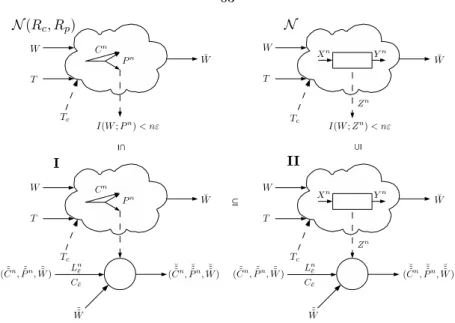
Proof of Theorem 11
The proof of secrecy for eavesdropping setE∈So ¯e /∈E is derived identically to equation (3.38) by the proof of Lemma4 and is therefore skipped. The random bits ˜Ptare are generated independently across different time states independently of the message W and the noise randomness. The channel codes aN,t at each time step have assigned each of the 2N(Rc+Rp) incoming messages smt(i) a random N-tuple X˜t(i).
N} is selected from the distribution p(x) that gives rise to the corresponding mutual information maxp(x)I(X;Y) and maxp(x)I(X;Z) of the noisy degraded broadcast channel ¯e. By setting the capacity CE of the side channel on each auxiliary receiver equal to CE= 1.
Proof of Theorem 12
The|E|additional receivers of the stacked network N(A) can decode messages (W , T) by having access to message W, the bits LnE through the side channel, and the public bits (PE)nwhere (PE)ndenotes ( (P(e1))n,. We need to prove how transferring bits Q˜˜n′ instead of P˜˜n′ does not affect the security of codeS(Ne¯(Rc, Rp)) the probability of error and entropy of the bits that cross the public bit pipe of channel ¯e In the example of Figure 4.1, we assume that the first storage node has failed and the redundancy of the system needs to be refreshed.
To explain our scheme, consider the (4,2) MDS code in Figure 4.1 and assume that one of the four nodes contains errors (say in both rows). This, of course, is just using the code's debugging capabilities to detect the error.
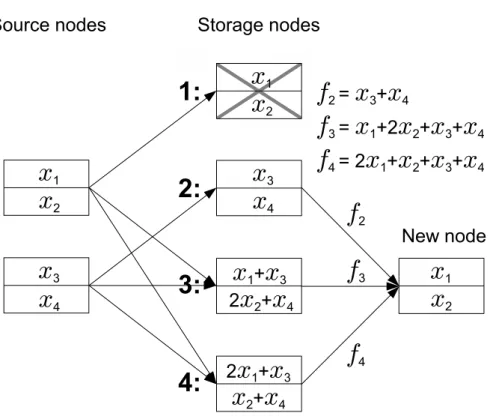
Model
Each of the three columns stored in the source nodes is encoded using the recursively (4,2) MDS of Figure 4.1. Since the code size (n, k) will be much smaller than N, the overall cost of storing the code description everywhere (including the verifier) is minimal. The storage nodes of the distributed storage system are assumed to have limited computational capabilities allowing them only to perform free operations in the finite field.
A malicious user can be computationally unlimited, know all the information stored in a distributed storage system, and can introduce errors into any of the storage nodes. We assume the existence of a special node called theverifier, which is assigned to check the integrity of data stored in different storage nodes.
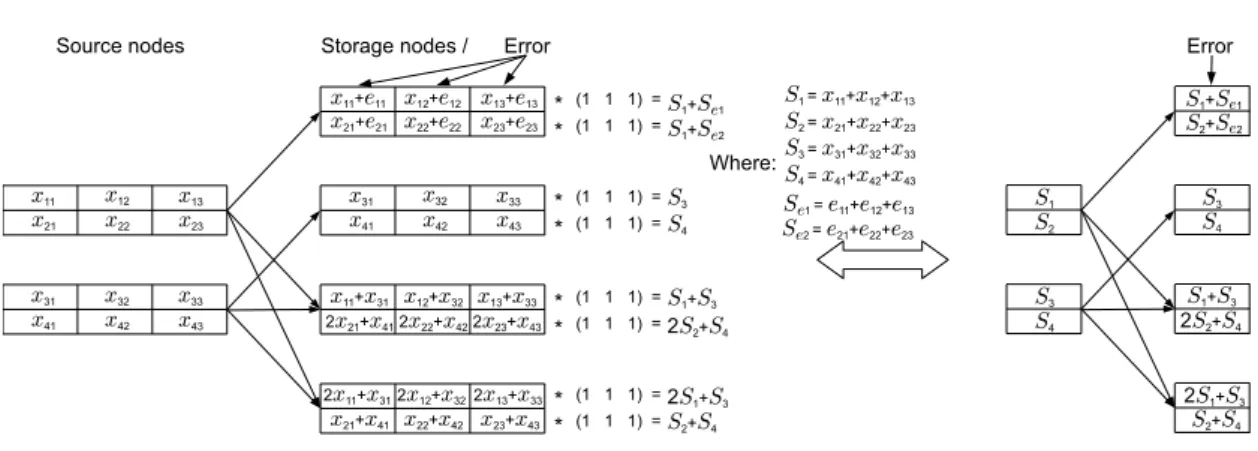
Random Hashes
Illustrating Example
General Case
From equation (4.1) it can be seen that the order of application of the MDS encoding to the different columns of the information matrix X and the calculation of the hash products can be interchanged ((GX)r=G(Xr)) that the process of identifying the faulty disks equivalent to finding the fault positions in a regular MDS code which is guaranteed to succeed if the minimum distance of the code (n−k+ 1) is greater than twice the number of faults 2t (this is indeed satisfied by the assumptions of Theorem 13). Each of the storage nodes must transmit the result of the hash product from all its (n−k) rows to the verifier, so that the total size of the hash communicated is H=n(n−k) logq, while the size of the fileM=k(n−k)Nlogq. Once all storage nodes have constructed the same pseudorandom vector r′, they calculate the inner product between vector r′ and the content stored on each row of the storage nodes.
In Theorem 14, the size of the required general randomness is reduced at the expense of a larger field size. Specifically, we showed that the difference in transmission time between network coding and routing can grow as the square root of the number of packets.
Future Work
Csiszar, “Ordinary randomness in information theory and cryptography – part i: Secret sharing,” Information Theory, IEEE Transactions on, vol. Kliewer, “Achievable Strategies for Secure Network Coding for General Networks,” Informative Workshop on Theory and Applications, 2010. M´edard, “A Theory of Network Equivalence–Part I: Point-to-Point Channels,” Theory of Information, IEEE Transactions on , vol.
Dikaliotis, Alexandros Dimakis, "On the delay of network coding over line networks," in Proceedings of the IEEE International Simposium on Information Theory, 2009. Banihashemi, "Coding delay analysis of chunked codes over line networks," inInternational Simposium on Network Coding (NetCod) ), 2012.
Multi-hop line network
Two parallel multi-hop line networks having links with different erasure probabilities . 12
The region N where function g(α, β) is defined on
Multi-hop network with the corresponding Markov chains
The A-enhanced network N (A)
The “equivalent” secret and communication networks
The “equivalent” secret and noiseless communication networks
A (4, 2) MDS code along with the repair of the first storage node
Illustration of the 3–extended version of the (4, 2) MDS code shown in Figure 4.1


